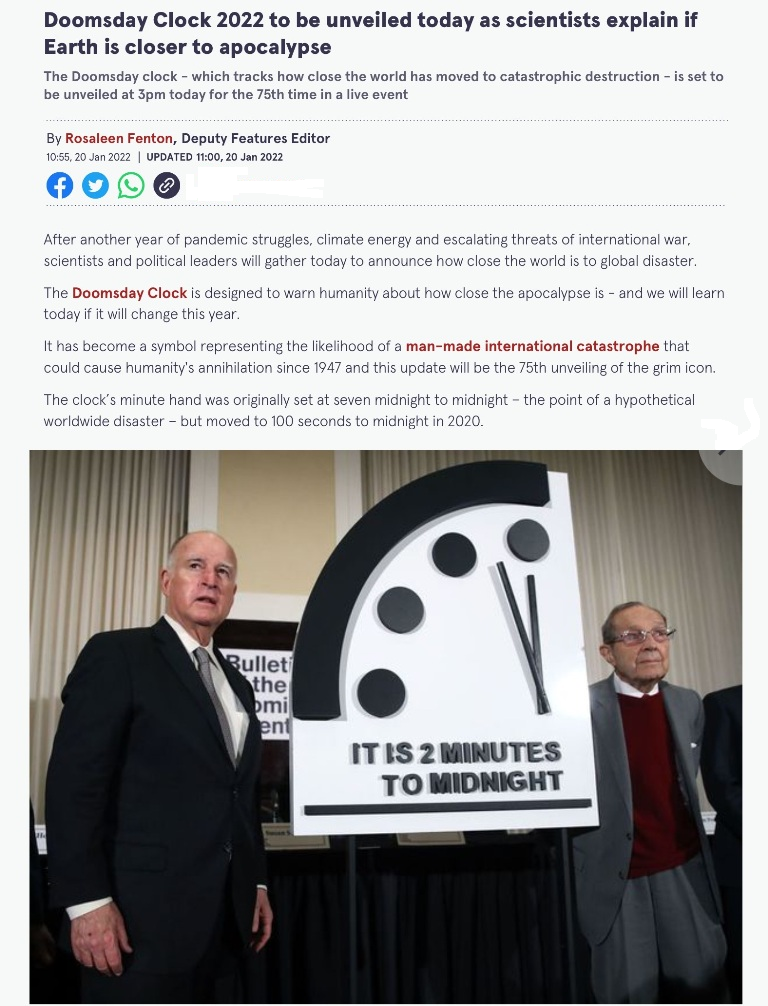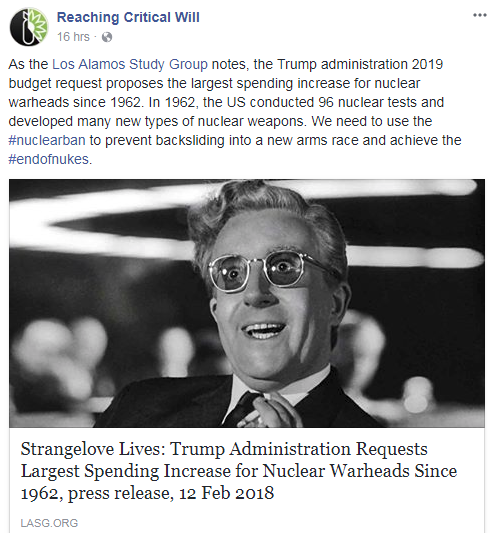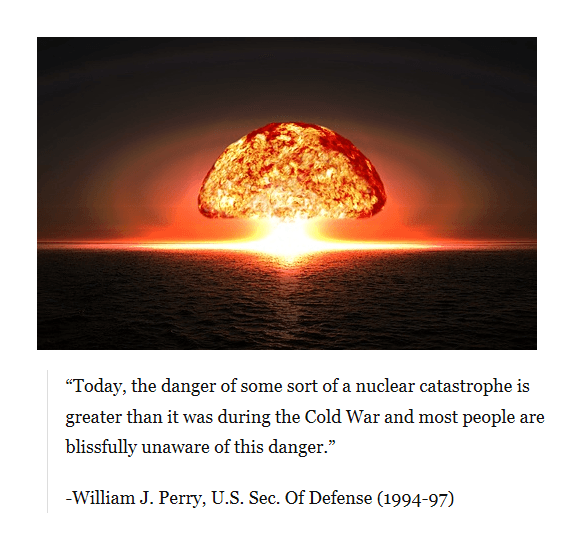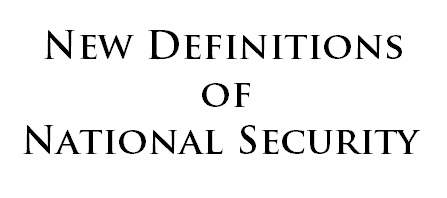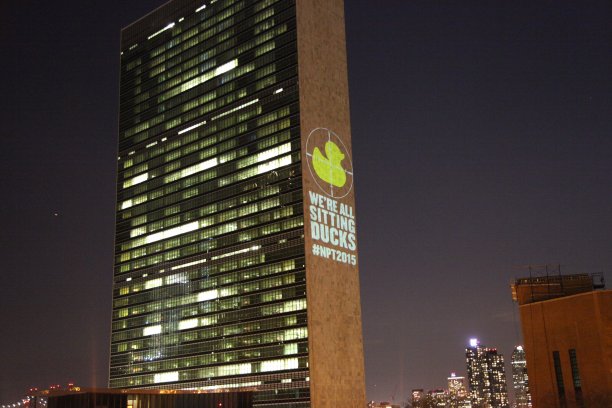Nuclear Proliferation: Difference between revisions
Siterunner (talk | contribs) No edit summary |
Siterunner (talk | contribs) No edit summary |
||
| Line 310: | Line 310: | ||
A Nuclear Life Chronology | |||
(Or How Not to Want the Bomb and How to Become a Lifelong Nonproliferation Activist) | |||
1963 was not a good year. I am remembering the sirens and then the teacher's voice ordering us to get under our desks in the duck and cover position we were taught when we were told the nuclear attack could come any minute. | |||
At first we joked 'it's a tuckin duckin' and some kids quacked quietly and snickered, but it didn't take long for most of us kids there in our East LA school to realize the adults were deadly serious and, as time passed, the snickering stopped. We waited. Under the desks. Quietly then, counting the minutes, hoping for an all clear, you can get up signal. | |||
* https://www.history.com/news/cuban-missile-crisis-timeline-jfk-khrushchev | |||
* https://en.wikipedia.org/wiki/Duck_and_cover | |||
Revision as of 15:04, 26 January 2022
2022
For those who are not techno types, the word 'CrowdStrike' means nothing, but for those who are involved in the Net and Web, in its development and security, CrowdStrike means state-of-the-art security services. The company was co-founded by this man, Dmitri Alperovitch.
- https://nationalsecurity.gmu.edu/dmitri-alperovitch/
- https://en.wikipedia.org/wiki/Dmitri_Alperovitch
- https://en.wikipedia.org/wiki/CrowdStrike
Following is a thread of his, about Russia and Ukraine, of casus belli, causes for war and what's likely being woven....
Take time to read his thoughts here.
GreenPolicy360, with Strategic Demands, also is following the news of imminent war -- and we are focusing as we have over the years on nuclear issues involved in nuclear weapons proliferation and dangers of nuclear use. The Ukraine is, although few in the press report it, a strategic nuclear issue...
Take a closer look -- https://strategicdemands.com/russia-ukraine-belarus-nato-eu-us/
····························································································································
2021/2020
Our advice to President-elect Biden: Break the dangerous pattern of nuclear competition with Russia
A 'Secret' Nuclear Weapons System
“I have built a nuclear—a weapons system that nobody’s ever had in this country before. We have stuff that you haven’t even seen or heard about. We have stuff that Putin and Xi have never heard about before. There’s nobody—what we have is incredible.”
Perhaps, a hyperglide system?
Or perhaps the US president was revealing the W76-2, a new nuclear warhead that fits on the Trident D-5 submarine-launched ballistic missiles.
As reported (publicly):
The U.S. Navy currently fields 12 nuclear-powered ballistic missile submarines, each equipped with approximately 20 Trident D-5 submarine launched missiles. Each D-5 carries between four and five W-76 warheads each. The W-76 has an explosive yield of approximately 100 kilotons, or about six times the power of the bomb dropped on Hiroshima. With a range of 4,600 miles, a U.S. missile submarine parked off the coast of Canada could rain up to 80-100 warheads on western Russia.
2019
'Limited' Nuclear Conflict
Visit GreenPolicy360's associate Strategic Demands
Regional Nuclear Conflict will deliver, science says, Global Nuclear Catastrophe
2018
2017 / 2016
(GreenPolicy360's continuing coverage of nuclear weapons issues is in association with www.strategicdemands.com)
Opinion by the New York Times Editorial Board / Oct. 26, 2017
The United States nuclear arsenal consists of 4,000 warheads, plus more than 2,000 warheads awaiting dismantlement. This number came into focus recently after a report that President Trump said in July that he wanted a huge increase in the country’s nuclear capability. ... more troubling, Mr. Trump can unilaterally order a nuclear strike at any time. Senator Bob Corker, a Republican, has called the president’s threats toward other countries reckless, saying they could set the nation “on the path to World War III.”
Every effort must be made to avoid the use of nuclear weapons. Reducing the nuclear stockpile is one important step. But legislators can go even further by requiring the president to seek a declaration of war from Congress before launching a first nuclear strike, as Senator Ed Markey of Massachusetts and Representative Ted Lieu of California, both Democrats, have proposed.
From Strategic Demands / GreenPolicy360
US Senator and Others Question US President's Fitness -- Again, Use of Nukes Raised
US President Threatens at the UN
News in Depth: The US President & Nuclear Codes
- James R. Clapper Jr., former director of US national intelligence, questioned President Trump’s fitness for office following the president's speech in Phoenix on Tuesday, August 22.
- “I really question his ability to be — his fitness to be — in this office... I also am beginning to wonder about his motivation for it — maybe he is looking for a way out...” Clapper continued that he is worried about the president’s access to nuclear codes.
- “In a fit of pique he decides to do something about Kim Jong Un, there’s actually very little to stop him,” Clapper said, referencing the US president and North Korean leader.
- “The whole system is built to ensure rapid response if necessary. So there’s very little in the way of controls over exercising a nuclear option, which is pretty damn scary.”
#HairTrigger: The Risks of Nuclear War Escalate
A Stark Nuclear Warning
By Jerry Brown
New York Review of Books / July 2016
Review of My Journey at the Nuclear Brink
by William J. Perry, with a foreword by George P. Shultz
I know of no person who understands the science and politics of modern weaponry better than William J. Perry, the US Secretary of Defense from 1994 to 1997. When a man of such unquestioned experience and intelligence issues the stark nuclear warning that is central to his recent memoir, we should take heed. Perry is forthright when he says: “Today, the danger of some sort of a nuclear catastrophe is greater than it was during the Cold War and most people are blissfully unaware of this danger.”1 He also tells us that the nuclear danger is “growing greater every year” and that even a single nuclear detonation “could destroy our way of life.”
In clear, detailed but powerful prose, Perry’s new book, My Journey at the Nuclear Brink, tells the story of his seventy-year experience of the nuclear age. Beginning with his firsthand encounter with survivors living amid “vast wastes of fused rubble” in the aftermath of World War II, his account takes us up to today when Perry is on an urgent mission to alert us to the dangerous nuclear road we are traveling.
Reflecting upon the atomic bombing of Hiroshima and Nagasaki, Perry says it was then that he first understood that the end of all of civilization was now possible, not merely the ruin of cities. He took to heart Einstein’s words that “the unleashed power of the atom has changed everything, save our modes of thinking.” He asserts that it is only “old thinking” that persuades our leaders that nuclear weapons provide security, instead of understanding the hard truth that “they now endanger it.”
Nuclear Issues / Cold War 2.0
New Arms Race Qua Old Arms Race
At the UN: Abolish Nuclear Weapons
- ············································································································
○ ○ ○ ○ ○ ○
2015 / 2014
Escalation, Echoes of Assured Destruction
○
Going BZhRK, Looking Backward, Looking Forward
http://strategicdemands.com/going_bzhrk/
○ ○ ○ ○ ○ ○ ○ ○ ○ ○ ○ ○ ○ ○ ○ ○ ○ ○ ○ ○ ○
GLOBAL NUCLEAR RISK REDUCTION
As world leaders descended on the United Nations in New York for the 2015 Non-Proliferation Treaty (NPT) Review Conference, the Global Zero Commission on Nuclear Risk Reduction — led by former U.S. Vice Chairman of the Joint Chiefs of Staff General James E. Cartwright and comprised of international military experts — issued a bold call for ending the Cold War-era practice of keeping nuclear weapons on hair-trigger alert.
"Hair-Trigger" Update (2017) -- http://strategicdemands.com/nuclear-hair-trigger
The Commission's extensive report calls for (1) an urgent agreement between the United States and Russia to immediately eliminate "launch-on-warning from their operational strategy, and to initiate a phased stand down of their high-alert strategic forces, beginning with taking 20% of both countries' nuclear forces off launch-ready alert within one year and 100% within 10 years; and (2) a longer-term global agreement requiring all nuclear weapons countries to refrain from putting nuclear weapons on high alert.
_ _ _ _ _ _ _ _ _
NY TIMES Opinion Pages | OP-ED
How to Avert a Nuclear War
By JAMES E. CARTWRIGHT and VLADIMIR DVORKIN
April 2015
We find ourselves in an increasingly risky strategic environment. The Ukrainian crisis has threatened the stability of relations between Russia and the West, including the nuclear dimension — as became apparent last month when it was reported that Russian defense officials had advised President Vladimir V. Putin to consider placing Russia’s nuclear arsenal on alert during last year’s crisis in Crimea.
Diplomatic efforts have done little to ease the new nuclear tension. This makes it all the more critical for Russia and the United States to talk, to relieve the pressures to “use or lose” nuclear forces during a crisis and minimize the risk of a mistaken launch.
The fact is that we are still living with the nuclear-strike doctrine of the Cold War, which dictated three strategic options: first strike, launch on warning and post-attack retaliation.
There is no reason to believe that Russia and the United States have discarded these options, as long as the architecture of “mutually assured destruction” remains intact.
For either side, the decision to launch on warning — in an attempt to fire one’s nuclear missiles before they are destroyed — would be made on the basis of information from early-warning satellites and ground radar. Given the 15- to 30-minute flight times of strategic missiles, a decision to launch after an alert of an apparent attack must be made in minutes.
This is therefore the riskiest scenario, since provocations or malfunctions can trigger a global catastrophe. Since computer-based information systems have been in place, the likelihood of such errors has been minimized. But the emergence of cyberwarfare threats has increased the potential for false alerts in early-warning systems. The possibility of an error cannot be ruled out.
American officials have usually played down the launch-on-warning option. They have argued instead for the advantages of post-attack retaliation, which would allow more time to analyze the situation and make an intelligent decision. Neither the Soviet Union nor Russia ever stated explicitly that it would pursue a similar strategy, but an emphasis on mobile missile launchers and strategic submarines continues to imply a similar reliance on an ability to absorb an attack and carry out retaliatory strikes.
Today, however, Russia’s early warning system is compromised. The last of the satellites that would have detected missile launches from American territory and submarines in the past stopped functioning last fall. This has raised questions about Russia’s very ability to carry out launch-on-warning attacks.
Partly to compensate for the loss of its space-based system, Russia has deployed prefabricated radar units that can be set up quickly along its borders. Some of these are already operational; some are still being tested. Unlike satellite networks, radar can provide accurate information about the scale and targeting of a missile attack — but only once a missile has entered its vicinity, which would most likely be 10 to 15 minutes after launch.
The upside of radar reporting is more information. The downside of having to wait is that it cuts the time for deciding whether to launch on warning. That in turn increases the likelihood of mistaken retaliation. For a submarine missile fired from the Norwegian Sea, Russia’s radar network would give its nuclear decision makers just 10 minutes to respond. America’s early warning systems can be expected to provide about twice as much time.
Clearly, for either side, these timelines are very compressed and the opportunities for ill-considered decisions very real. Launch-on-warning puts enormous strain on the nuclear chains of command in both countries.
In theory, no sensible head of state would authorize a launch-on-warning strike after receiving information that just one missile, or a small number of missiles, were inbound, on the assumption that this was not an intentional, full-scale attack. But the launch-on-warning doctrine still rules in both Russia and the United States — in which case the risk, however small, of cataclysmic error remains.
This risk should motivate the presidents of Russia and the United States to decide in tandem to eliminate the launch-on-warning concept from their nuclear strategies. They should reinstitute military-to-military talks, which were suspended over the Ukraine crisis, to pursue this stand-down as an urgent priority. (A joint decision on this would not destabilize nuclear deterrence: Both countries still have nuclear forces designed to withstand a first-strike attack, guaranteeing retaliatory strikes.)
To reinforce this accord, both countries should refrain from conducting military exercises that involve practicing missile launches based on information from early warning systems. Even if this restraint cannot yet be fully verified, it would be a valuable contribution to strategic stability — and, of course, to preventing an inadvertent nuclear war. This would be a positive step ahead of the 'Non-Proliferation Treaty Review Conference' that the United Nations will host later this month.
Detailed verification measures can come later, once better Russian-American relations are restored. The technical implementation of a decision to abandon the launch-on-warning concept would fall within the framework of the New Start treaty. A phased reduction of the combat readiness of the strategic nuclear forces would provide a safer time buffer for nuclear decision making.'
In periods of heightened tensions and reduced decision times, the likelihood of human and technical error in control systems increases.
Launch-on-warning is a relic of Cold War strategy whose risk today far exceeds its value.
Our leaders urgently need to talk and, we hope, agree to scrap this obsolete protocol before a devastating error occurs.
A Nuclear Life Chronology
(Or How Not to Want the Bomb and How to Become a Lifelong Nonproliferation Activist)
1963 was not a good year. I am remembering the sirens and then the teacher's voice ordering us to get under our desks in the duck and cover position we were taught when we were told the nuclear attack could come any minute.
At first we joked 'it's a tuckin duckin' and some kids quacked quietly and snickered, but it didn't take long for most of us kids there in our East LA school to realize the adults were deadly serious and, as time passed, the snickering stopped. We waited. Under the desks. Quietly then, counting the minutes, hoping for an all clear, you can get up signal.
◊

